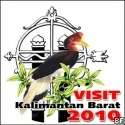I first met His Holiness the Dalai Lama in 1996. Accompanying me was a parliamentarian and two other friends. We were fortunate enough to have a private audience with him. When I said we were from Indonesia, he immediately reacted: "Oh yes, yes, yes ... Indonesia .... Tibet has very strong relations, strong ties with Indonesia."
"Atisha, was a monk from India. He went to Indonesia to learn from the Indonesian master," he said.
Fortunately, I knew the story.
Indeed, not many Indonesians remember we used to be a treasure house of wisdom. We did not import spirituality from India; indeed, even the Indian pundits came to our archipelago to learn from our indigenous masters.
Later, Atisha traveled to Tibet, where he propagated the teachings of his master.
The meditation he taught is still being practiced by the Tibetans. It is called Tong-Len, literally meaning "The Meditation of Terima and Kasih, Receiving and Giving". The common phrase terima kasih, now meaning "thank you", is no ordinary phrase.
There's a deep philosophy behind it. It reflects our view of life and it projects our deep rooted belief. We, Indonesians, believe, or at least once believed, in the law of gratitude. We do not, or did not, need a movie like The Secret to tell us to "be grateful" for all we receive from the universe.
More than 800 years ago, the Indian pundit traveled to Sumatra, then known as Svarna Dvipa, to learn from Dharmakirti Suvarnadvipi, Dharmakirti of Svarna Dvipa. He spent more than 10 years with his master. He documented each word he heard and each lesson he learned.
We, Indonesians, do not have any record of this.
Later, this meditation would be used by Tibetan medicine men and doctors. They would imagine their patients' pain and draw it into themselves. This is the first part of meditation, terima -- receiving. Then, in the second part, they would send out their energy of well being, kasih -- giving.
The was technique soon replaced their herb-based anesthesia. Let me remind you again, all this happened over 800 years ago.
The beauty of this technique is, the receiver of pain, the recipient, can process pain and transform it into well-being. All negativities can be drawn into oneself, be processed and then projected out as positive energy. Now the technique is being used by many Western neurologists, as part of transcranial magnetic stimulation therapy, to relieve the suffering of some stroke victims.
"But I have to emphasize, we haven't got a clue what's going on," said Max Bennett, professor at the University of Sydney and one of the world's top neurologists.
"It's a phenomenon. But in one sense, it does indicate that there are a lot of things that we know nothing about in Western science," he said.
"We know by the year about 2020, the greatest disabling phenomenon for the health of the human race will be depression. Not cancer, not heart disease, but depression," he said.
This drug-free technique from our own archipelago can ultimately replace the expensive morphine-based pain killers.
When discussing the Chinese occupation of his homeland, the Dalai Lama said, "This is the meditation which frees me from hatred. I use it every day to send out positive energy and feelings to the Chinese."
I personally can never ever forget the words of the Dalai Lama: "We Tibetans are always thankful to Indonesia and Indonesians, for this beautiful Tong Len teaching." Those of you who have seen and heard him may recall the way he speaks. He uses minimal words, short sentences and is not burdened by the sophisticates of English grammar. I bear witness to Dalai Lama's terima kasih for us, Indonesians and our land, Indonesia. I stand witness to his gratefulness, his gratitude.
Now, as Indonesians let's remind ourselves of what it means to be thanked. It is kembali kasih, and when reading between the lines it means "I am equally grateful to you."
Unlike the American "welcome" and British "never mind", Indonesians return "gratitude with gratitude". Let us now face the mirror of our consciousness and let us check the face of our souls. Have we returned the Tibetan gratitude with gratitude?
For almost a millennium the Tibetans have preserved the missing pages of our history. They have preserved them with a sense of gratitude. What have we done for them? How do we return our gratitude to them?
The European Union, the United States, the United Nations and countries like Poland, Germany, India and Taiwan have all commented on the recent uprising in Tibet against the illegal occupation of their homeland by the Communist regime of China.
What do we have to say? Perhaps we find it more comfortable to remain silent as we have been doing recently. But, let us remind ourselves this is not our tradition, this is not our culture.
Let us remind ourselves of what Sukarno, the father of our nation, once said: "Freedom to be free* For, of what use would be 'freedom from fear'; of what use would be 'freedom to express, freedom to believe, and freedom from poverty, freedom from fear' -- if there is no 'freedom to be free?'"
Time and again, Sukarno would repeat that the fruits of Indonesia's freedom would not be enjoyed by Indonesians alone and that Indonesia would unceasingly work for the freedom of all peoples from all lands.
I have no space left to discuss the illegalities of the Chinese occupation of Tibet. Any student of history cannot but condemn the occupation. We, as a nation, must immediately stand up against the occupation. Otherwise, generations to come may laugh at our cowardice, unclear foreign policies and our negligence toward history. Aside from the Tibetan issue, I am afraid our attitude may ultimately harm us.
"Atisha, was a monk from India. He went to Indonesia to learn from the Indonesian master," he said.
Fortunately, I knew the story.
Indeed, not many Indonesians remember we used to be a treasure house of wisdom. We did not import spirituality from India; indeed, even the Indian pundits came to our archipelago to learn from our indigenous masters.
Later, Atisha traveled to Tibet, where he propagated the teachings of his master.
The meditation he taught is still being practiced by the Tibetans. It is called Tong-Len, literally meaning "The Meditation of Terima and Kasih, Receiving and Giving". The common phrase terima kasih, now meaning "thank you", is no ordinary phrase.
There's a deep philosophy behind it. It reflects our view of life and it projects our deep rooted belief. We, Indonesians, believe, or at least once believed, in the law of gratitude. We do not, or did not, need a movie like The Secret to tell us to "be grateful" for all we receive from the universe.
More than 800 years ago, the Indian pundit traveled to Sumatra, then known as Svarna Dvipa, to learn from Dharmakirti Suvarnadvipi, Dharmakirti of Svarna Dvipa. He spent more than 10 years with his master. He documented each word he heard and each lesson he learned.
We, Indonesians, do not have any record of this.
Later, this meditation would be used by Tibetan medicine men and doctors. They would imagine their patients' pain and draw it into themselves. This is the first part of meditation, terima -- receiving. Then, in the second part, they would send out their energy of well being, kasih -- giving.
The was technique soon replaced their herb-based anesthesia. Let me remind you again, all this happened over 800 years ago.
The beauty of this technique is, the receiver of pain, the recipient, can process pain and transform it into well-being. All negativities can be drawn into oneself, be processed and then projected out as positive energy. Now the technique is being used by many Western neurologists, as part of transcranial magnetic stimulation therapy, to relieve the suffering of some stroke victims.
"But I have to emphasize, we haven't got a clue what's going on," said Max Bennett, professor at the University of Sydney and one of the world's top neurologists.
"It's a phenomenon. But in one sense, it does indicate that there are a lot of things that we know nothing about in Western science," he said.
"We know by the year about 2020, the greatest disabling phenomenon for the health of the human race will be depression. Not cancer, not heart disease, but depression," he said.
This drug-free technique from our own archipelago can ultimately replace the expensive morphine-based pain killers.
When discussing the Chinese occupation of his homeland, the Dalai Lama said, "This is the meditation which frees me from hatred. I use it every day to send out positive energy and feelings to the Chinese."
I personally can never ever forget the words of the Dalai Lama: "We Tibetans are always thankful to Indonesia and Indonesians, for this beautiful Tong Len teaching." Those of you who have seen and heard him may recall the way he speaks. He uses minimal words, short sentences and is not burdened by the sophisticates of English grammar. I bear witness to Dalai Lama's terima kasih for us, Indonesians and our land, Indonesia. I stand witness to his gratefulness, his gratitude.
Now, as Indonesians let's remind ourselves of what it means to be thanked. It is kembali kasih, and when reading between the lines it means "I am equally grateful to you."
Unlike the American "welcome" and British "never mind", Indonesians return "gratitude with gratitude". Let us now face the mirror of our consciousness and let us check the face of our souls. Have we returned the Tibetan gratitude with gratitude?
For almost a millennium the Tibetans have preserved the missing pages of our history. They have preserved them with a sense of gratitude. What have we done for them? How do we return our gratitude to them?
The European Union, the United States, the United Nations and countries like Poland, Germany, India and Taiwan have all commented on the recent uprising in Tibet against the illegal occupation of their homeland by the Communist regime of China.
What do we have to say? Perhaps we find it more comfortable to remain silent as we have been doing recently. But, let us remind ourselves this is not our tradition, this is not our culture.
Let us remind ourselves of what Sukarno, the father of our nation, once said: "Freedom to be free* For, of what use would be 'freedom from fear'; of what use would be 'freedom to express, freedom to believe, and freedom from poverty, freedom from fear' -- if there is no 'freedom to be free?'"
Time and again, Sukarno would repeat that the fruits of Indonesia's freedom would not be enjoyed by Indonesians alone and that Indonesia would unceasingly work for the freedom of all peoples from all lands.
I have no space left to discuss the illegalities of the Chinese occupation of Tibet. Any student of history cannot but condemn the occupation. We, as a nation, must immediately stand up against the occupation. Otherwise, generations to come may laugh at our cowardice, unclear foreign policies and our negligence toward history. Aside from the Tibetan issue, I am afraid our attitude may ultimately harm us.
Note: This article is also published on The Jakarta Post
Anand Krishna
Spiritual Writer (http://www.aumkar.org)
Source: http://EzineArticles.com/?expert=Anand_Krishna






